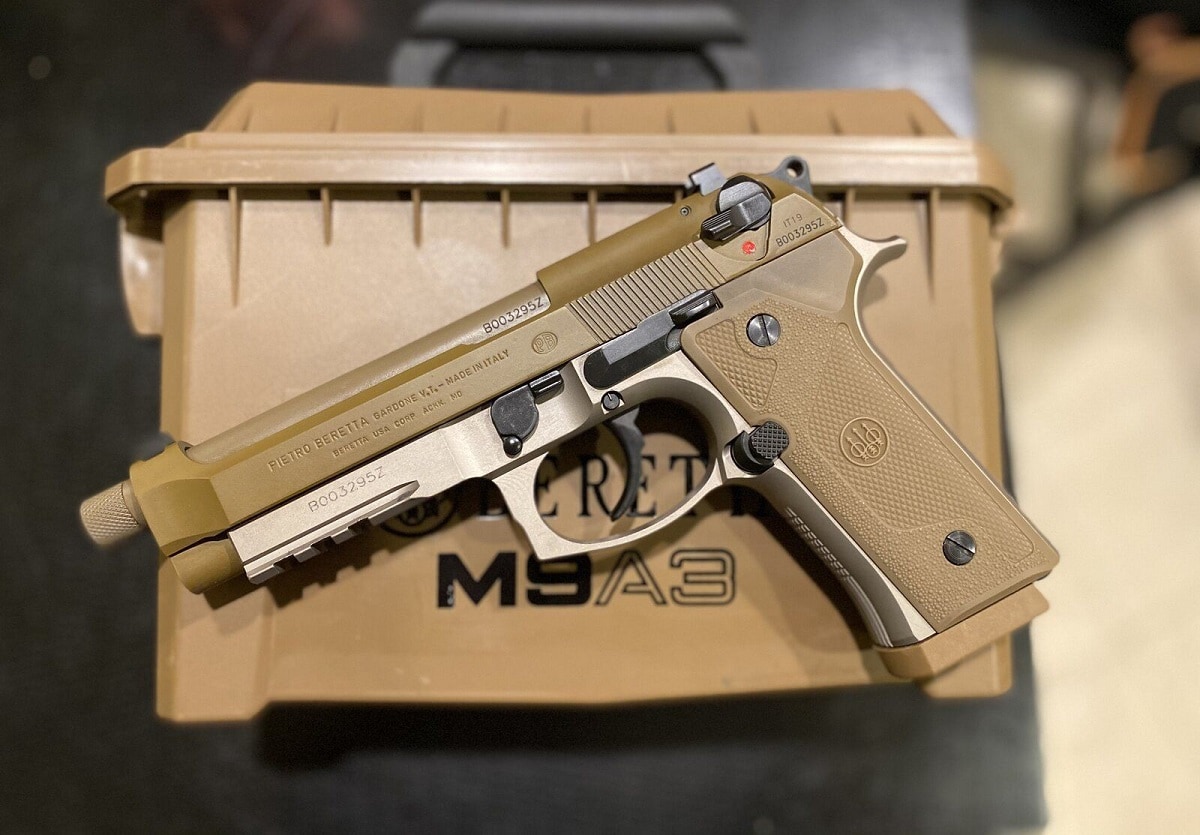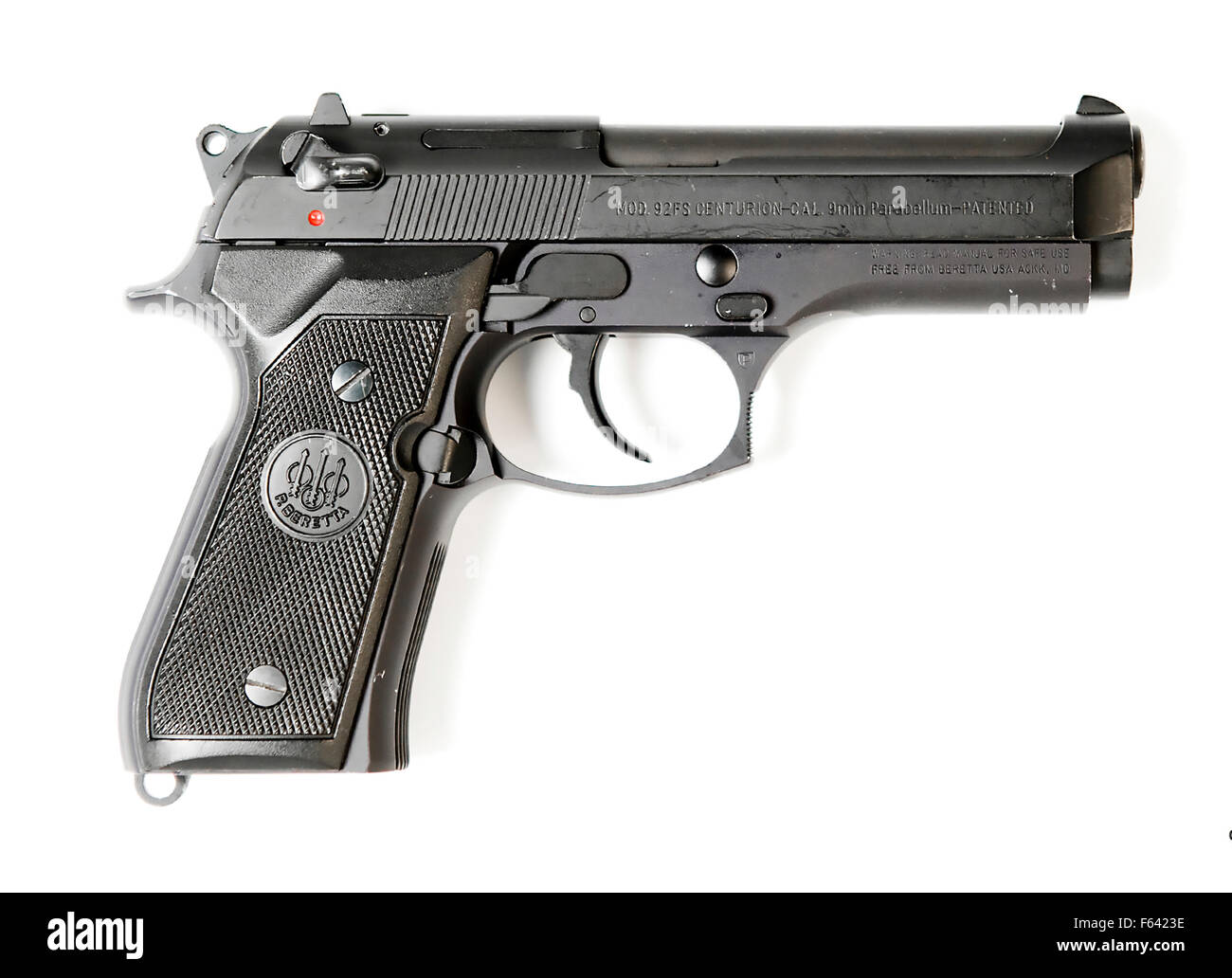Beretta 92 History - The Beretta 92 (also Beretta 96 and Beretta 98) is a series of semi-automatic pistols designed and manufactured by Beretta of Italy. The Beretta 92 was designed in 1975 and production began in 1976. Many variations in different calibers are still used for performance.
The US Army replaced the M1911A1 .45 ACP pistol in 1985 with the Beretta 92FS, designated the "M9".
Beretta 92 History

The Beretta 92 pistol evolved from earlier Beretta models, notably the M1923 and M1951. From the M1923 comes the op-slide design, while the alloy frame and locking block, originally from the Walther P38, were first used in the M1951. The grip angle and front sight integrated with the slide were also common to earlier Beretta pistols. What were perhaps the two most important advanced design features of the Model 92 had first appeared on its immediate predecessor, the Model 84 .380 caliber of 1974. These improvements were both to the magazine, which featured direct feed; i.e. there was no feed ramp between the magazine and the chamber (a Beretta innovation in pistols). In addition, the magazine had a "double stack" design, a feature originally introduced in 1935 on the Browning Hi-Power.
We Hate The Beretta M9, But Why?
Carlo Beretta, Giuseppe Mazzetti and Vittorio Valle, all expert firearms designers, contributed to the final design in 1975.
Production began in May 1976 and ended in February 1983. About 7,000 units were of the first "step slide" design and 45,000 were of the second "straight slide" type.
To meet the requirements of some law enforcement agencies, Beretta modified the Beretta 92 by adding a slide-mounted combination safety and decock lever, replacing the frame-mounted manual thumb safety. This led to the 92S, which was adopted by several Italian law enforcement and military units. The magazine release button is located on the underside of the grip, as is common in Europe. This model was produced from 1978 to 1982.
The 92SB, originally called the 92S-1, was specifically designed for USAF trials (which it won), the officially adopted model name being the 92SB. Additional features include a firing pin lock (hence the addition of the "B" to the name), transverse safety levers, 3-point sights, and moved the magazine release lock from the bottom of the handle to the bottom of the bottom of the guard on the trigger. The later movement of the magazine release button means that earlier models (92 and 92S) do not necessarily use later magazines, unless they have notches in both areas.
A History Of Beretta's Amazing 100 Year 9mm Pistol Legacy
A compact version with a shortened barrel and slide and 13-round magazine capacity known as the 92SB Compact was produced from 1981 to 1991.
A gold-plated, diamond-set Beretta 92F 9mm Parabellum pistol with matching suppressor confiscated from a safe house belonging to Joaquín "El Chapo" Guzmán. (Source: Drug Forces Administration Museum and Cter Visitors)
In 1984, Beretta introduced a slightly modified version of the 92SB model to create the 92SB-F ("F" added for model test dote in US government federal testing) with the following changes:

The French Army adopted a modified version of the 92F with a lever-only shootdown as the PAMAS G1. These guns have tellurium in the slide, which makes steel brittle and as such has a lifespan of approx. 6000 shots.
Ncstar Beretta 92 Pistol Accessory Rail Adapter (madber), Optics
The 92FS has a large hammer pin that fits into a slot on the underside of the slide. The main purpose is to prevent the sled from flying off the frame backwards if it breaks. This was in response to defective slides reported during US military tests.
The 92FS also came as the 92FS Cturion model which featured the shorter runner and slider of the 92 Compact on a full size 92FS frame.
The op-slide design of the Beretta 92 ensures smooth feeding and ejection of ammunition and enables easy clearance of obstacles. Hard chrome-plated barrel bore reduces barrel wear and protects against corrosion. The drop lock block design provides good accuracy and operation with suppressors due to the barrel's in-line stroke. This is in contrast to the complex stroke of Browning designed barrels. The magazine release button is reversible with simple field tools. The reversible magazine release considerably simplifies left-handed operation.
It has become increasingly popular to reduce the weight and cost of the gun, as well as increase corrosion resistance by using polymers. Starting around 2000, Beretta started replacing some parts with polymer and polymer-coated metal. Polymer parts include the recoil spring guide rod (which is also now slotted), magazine bottom plate, magazine tracks, and mainspring cap/lanyard. Polymer coated metal parts include the left side safety lever, trigger and magazine release button.
Review: Beretta 92x Performance Defensive
To keep in line with the introduction of laws in some localities restricting magazines that hold more than 10 rounds, Beretta now produces magazines that hold less than the standard factory 15 rounds. These magazines have a heavier fold (deeper side reliefs) to reduce available space while maintaining the same external dimensions and ensuring that these magazines can be used in existing firearms. Beretta also produces 15-round "Sand Resistant" magazines to address problems with subcontracted magazines and 17-round magazines that come with the A1 models. Both magazines work in the earlier 92 series and M9 model pistols.
The Italian magazine manufacturer Mec-Gar now produces blue and nickel finished magazines with a capacity of 18 rounds, which are a perfect match for the 92 series magazine. Mec-Gar also produces an extended 20-round blued magazine that protrudes below the frame 3 ⁄ in (19 mm). These magazines provide users in unrestricted states with a larger capacity magazine.
The Vertec is a variant of the 92 series with a reshaped straight backstrap, detachable sights, 1-slot accessory rail, flared magwell, and 4.7-inch barrel.

The 90two is a 9mm/.40 variant of the 92 series with a redesigned, thicker slide and frame to accommodate an accessory rail, full dovetail front sight and .40 S&W pressure. Other additional features include a recoil spring, internal recoil buffer, user-replaceable monogrips, and 17-round magazines.
Beretta 92 Frame Disassembly Video
The limited edition 92 FS Ctnial (500 units) commemorates the adoption by the Italian Army of Beretta's first semi-automatic pistol, the 1915 model. This Ctnial 92 is distinguished by its frame-mounted manual safety and single-action mechanism. The Beretta medallion in each panel of the wooden grip shows the anniversary dates in Roman numerals, also engraved on both sides of the steel slide. The gun is packaged in a custom M2A1 ammo box with the Ctnial logo.
The M9A1 was adopted by the USMC in 2006. It adds a 1-slot Picatinny rail, more aggressive front and rear controls, and a magazine bezel for easier reloading of the weapon. The M9A1 pistols are sold with PVD (Physical Vapor Deposition) coated magazines developed to better withstand the conditions in the sandy terrain of Iraq and Afghanistan.
The M9A3 (the M9A2 concept never went into production) was released in 2015, as a potential upgrade for the US military, in response to trials with the modular weapon system. The main updates to the M9A3 were a 3-slot Picatinny rail, slimmer vertical grip, detachable wraparound grips that can be switched between the Vertec style and the "older" M9 style,
Fully detachable tritium night sights and a universal slide, which makes the gun convertible from kill-safety mode to kill-only mode. The barrel tip is pre-threaded for easy addition of a suppressor.
List Of Beretta 92 Models
Beretta/Wilson 92G Brigadier Combat, a collaboration between Wilson Combat and Beretta. It features a heavy Brigadier Slide, stainless steel barrel, single function ambi-decock and a refined action.
These pistols differ from the standard Brigadier in having a military-standard 1913 picatinny rail, all steel controls (as opposed to polymer-coated steel), takedown only (model G), 4.7" angled barrel, knurled steel forend rail, thin profile G-10 grip, rounded trigger guard, lighter hammer spring used in the "D" model, Elite II hammer, and its own unique serial number with a "WC" prefix among other features.
The Elite LTT was introduced by Beretta in 2018, in collaboration with firearms instructor Ernest Langdon. The LTT uses the Vertec slide with forward tension serrations on a modified M9A1 frame and carries Langdon Tactical G10 grips. The gun features a G-model decocker, dovetail front sight, steel trigger and guide rod, upgraded springs, and a 4.7-inch stainless steel barrel with target crown, just to name a few of the more notable features.

The 92x was introduced in 2019 as an update of the 92 series and standardization of the Vertec platform. Like the M9A3, features a 3-slot Picatinny rail, slimmer vertical grip, detachable wraparound grips that can be switched between the Vertec style and the "older" M9 style, fully detachable sights (high visibility orange dot) and a universal slide , which makes the gun convertible from kill-safety mode to kill-only mode. Unlike the M9A3, the barrel is not threaded. The 92x series is available in compact, cuturion and full-size variants.
Beretta 92 Variants
The 92x Performance was introduced in 2019, along with the 92x as a competition pistol. Like the 92x, it has a 3-slot Picatinny rail, slimmer vertical grip, detachable wraparound grips that can be switched between Vertec-style and "older" M9-style, dovetail sights. The 92x Performance includes a red fiber optic front sight, adjustable rear sight, front and rear sliders
Beretta f 92, beretta 92 leather holster, beretta 92 compact holster, beretta 92 elite, serpa holster beretta 92, beretta 92 review, blackhawk beretta 92 holster, beretta 92 holster, safariland beretta 92, 92 compact beretta, beretta 92 fs holster, beretta 92 magazine pouch
0 Comments